This post may contain affiliate links. Please see my disclosure policy for details.
Did you know there is a sunken palace in Istanbul that you can visit beneath the busy streets of Sultanahmet?
It’s called Basilica Cistern and it is the largest ancient cistern in the city created in the 6th century.
It was used to store water sourced from the Valens Aqueduct and provided water to the Byzantine and Ottoman Palaces of Constantinople.
The most intriguing part of the attraction is the pair of upside-down Medusa Heads. No one really knows where they came from and their purpose is a bit of a mystery.
I think that the Basilica Cistern is a must-visit attraction in Istanbul as it feels like you’ve been transported back in time to the Byzantine Empire.
Here is how to visit Istanbul’s Subterranean Palace, the current cost and the best time to go!

Basilica Cistern history
This ancient cistern was constructed in the 6th century by Eastern Roman Emperor Justinian I. Some say that he expanded an earlier site left over from Emperor Constantine.
The reason why it is called Basilica Cistern is due to it being built over the former Stoa Basilica on the First Hill of Constantinople. It also has the name ‘Yerebatan Sarayı’ or Sunken Palace.
The cistern is suspended by 336 columns that are all 9 metres high. The space could hold up to 80,000 tons of water sourced from the Valens Aqueduct.
It provided essential water to the Emperor in the Imperial Palace and surrounding buildings of the city.
Later, it would provide water for the Topkapi Palace after Sultan Sultan Mehmed II of the Ottoman Empire conquered the city in the 15th century.
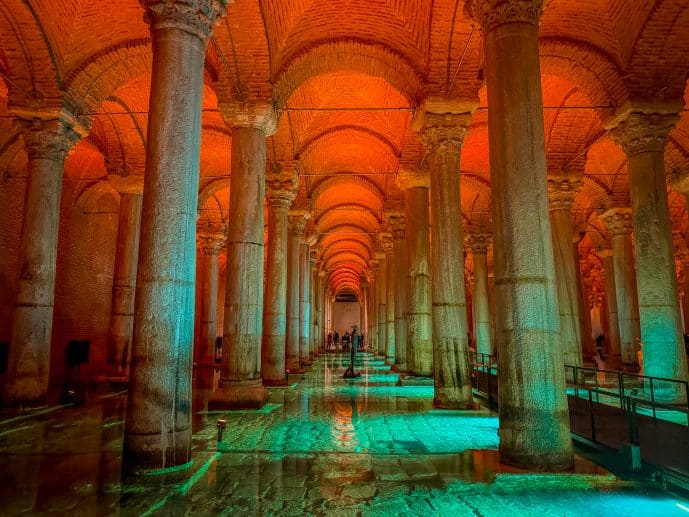
It was later ignored by Topkapi royalty but it was still regularly used by locals in Sultanahmet. It was later ‘rediscovered’ by a French explorer Petrus Gyllius in the 16th century.
He made important historical recordings of the cistern and noted that he took a lamp-lit boat ride, seeing schools of fish and watched on as locals sourced water here and brought it up to the surface.
It had several renovations during the Ottoman Empire and was largely abandoned.
A huge cleanup took place during the 1980s where they drained the water and cleared out all the mud and refuse.
It was during these excavations that they discovered the famous Medusa Heads. Once it was clear, it opened up to the public as a museum in 1987.
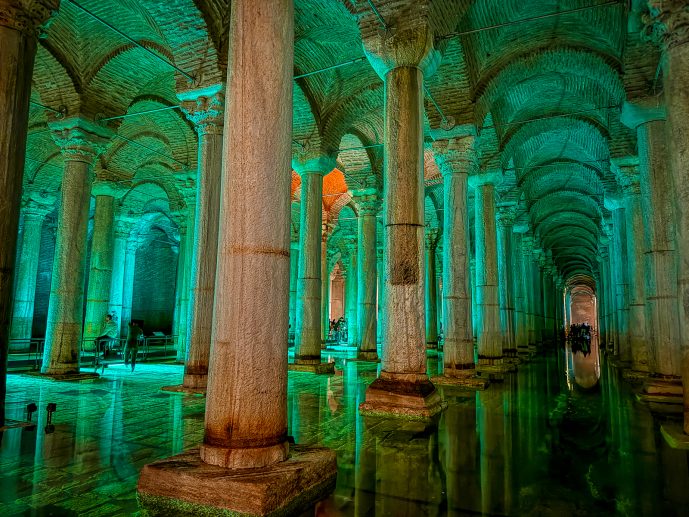
Why is Medusa in Basilica Cistern?
The most intriguing part of this entire attraction is the upside-down Medusa heads. Out of 336 columns, only two have faces and they remain a bit of a mystery.
As no one really knows where they came from or why they are here, there are many theories about why Medusa is inside Basilica Cistern. In ancient times, Medusa was used as a symbol to ward off evil spirits.
One theory is simply that Emperor Justinian I used the statues of a sacked ancient temple to recycle building materials.
The other is that they are placed upside-down as a symbol of Christianity winning over Paganism.
Some believe the heads were simply there for decoration to make it appear more mysterious as the legends were well-known in the Byzantine period.
Medusa is believed to have the ability to turn people to stone, so maybe they were placed upside down by superstitious builders in the hope of diminishing her power. Who knows!
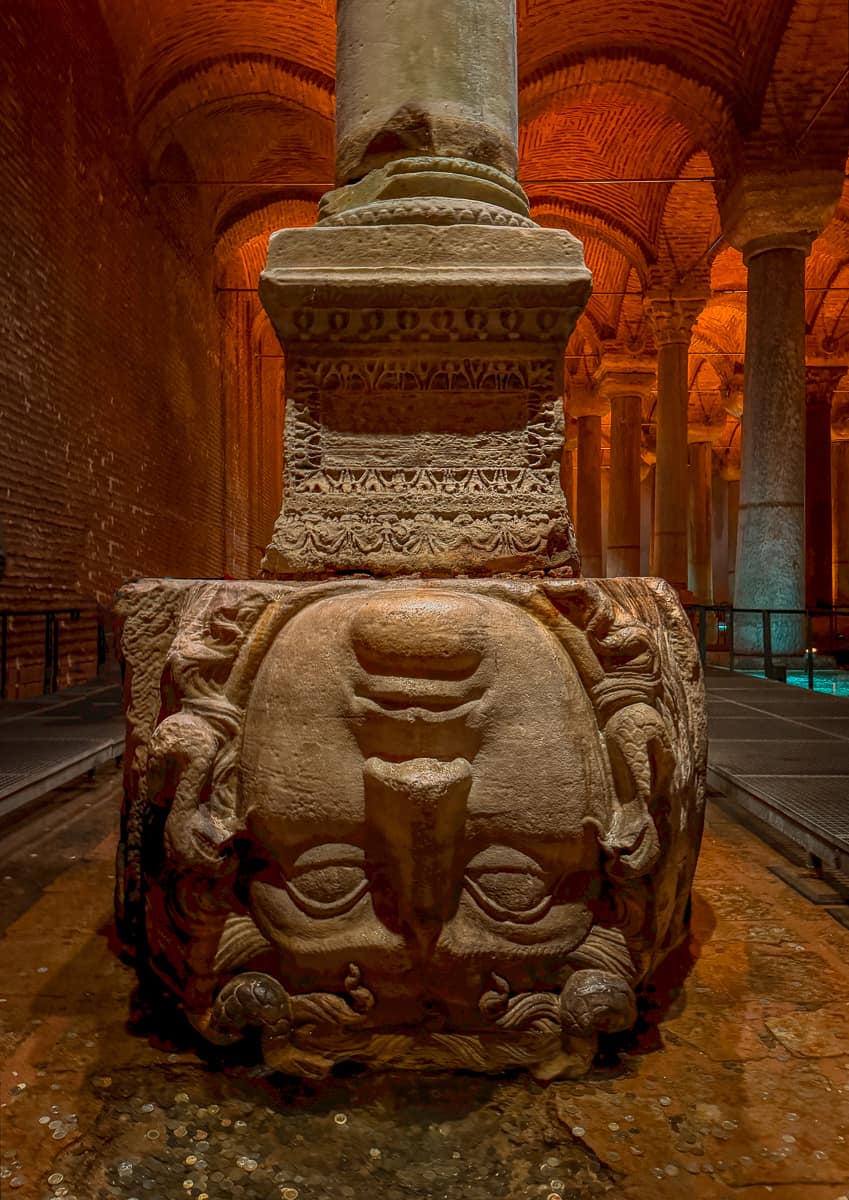
Who is Medusa?
In Greek mythology, Medusa is a Gorgon who has a head of snakes and anyone who looks upon her is turned to stone.
In the traditional legend, Perseus cuts off her head and saves the day as a glorified hero essentially ‘defeating the monster’. But, that is just one chapter of her sad story.
Although often portrayed as an evil villain, Medusa is widely misunderstood and the tale of why she was cursed is actually very tragic.
Medusa was a victim of jealousy and scorn. She was cursed by Athena while worshipping the Goddess in her temple.
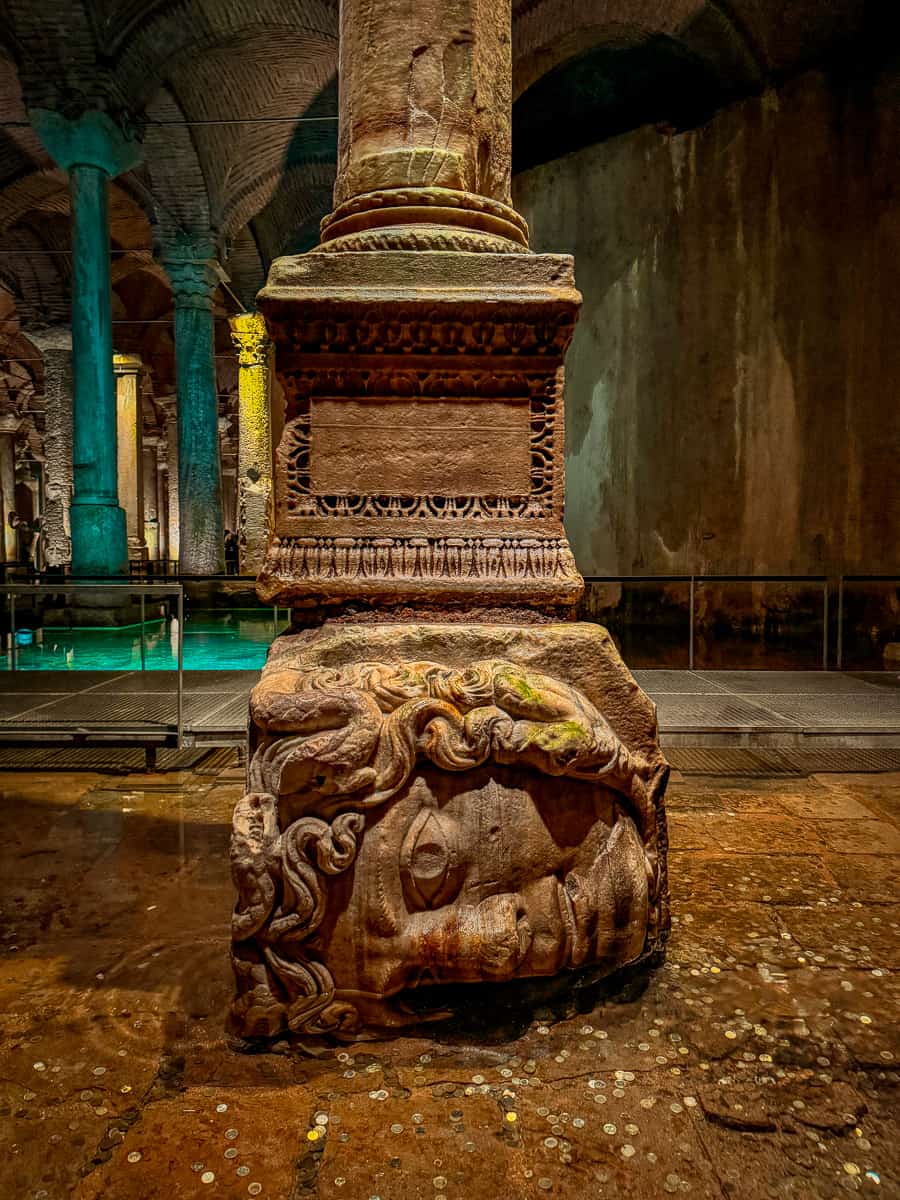
Poseidon was so enamoured by Medusa’s beauty he tried to seduce her. When his advances didn’t work, he forced himself on her in Athena’s temple.
In revenge, despite Medusa being one of her priestesses, Athena turned her gorgeous hair into snakes and no man could ever gaze upon her beauty again without turning to stone.
Some say Athena was angry that Medusa was no longer chaste and this is why she cursed her. Others say that Athena was protecting Medusa from further male attention and that’s why she cast her out.
In the end, Perseus is tricked into pursuing Medusa unprovoked to prove himself and cuts off her head as she is the only Gorgon that can die. Her head is later mounted on Athena’s shield.
I always feel sorry for Medusa as she was not evil at all and her unwanted curse ultimately damned her. If anything, Athena is the evil one as she should have taken out her anger on Poseidon.
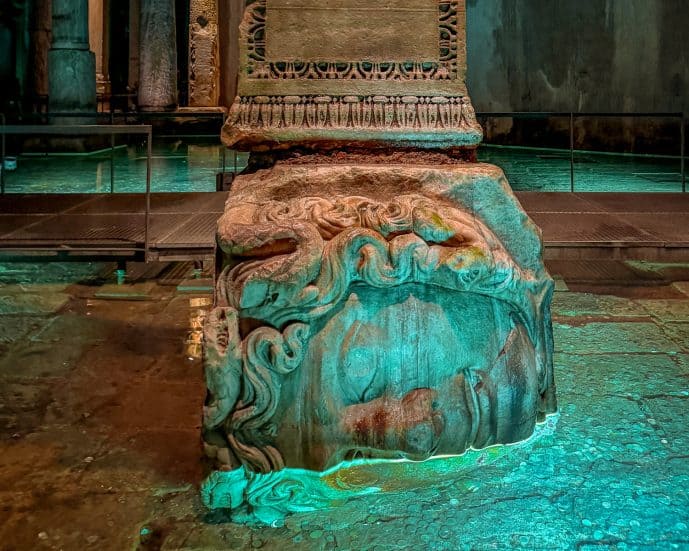
What movies were filmed in Basilica Cistern?
The intrigue of this place has not only attracted historians and tourists but also Hollywood film crews as well.
You may recognise Basilica Cistern in the classic James Bond movie From Russia With Love (1963) starring Sean Connery.
In the movie, James Bond takes a boat ride with an MI6 spy through the cistern to a secret ‘Soviet’ hideout.
Also, this cistern is featured in The International (2009), Brotherhood of Tears (2013) and Dan Brown’s Inferno (2016).
If you play video games, you’ll see the Yerebatan Cistern in Assassin’s Creed: Revelations and also Age of Empires IV.
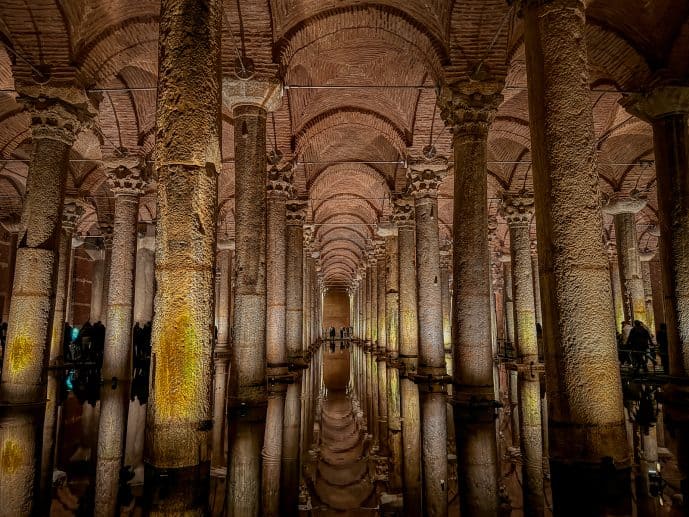
How to get to Basilica Cistern in Istanbul
I always think it’s incredible that this cistern can be found beneath the busy tourist streets of Sultanahmet.
You will find the ticket entrance opposite the west side of the Hagia Sophia between the streets of Alemdar and Yerebatan.
There is usually a long queue to go inside so you’ll most likely see the line of people before you get to the entrance.
Once you have your ticket, you’ll descend underground to explore this mysterious sunken palace.
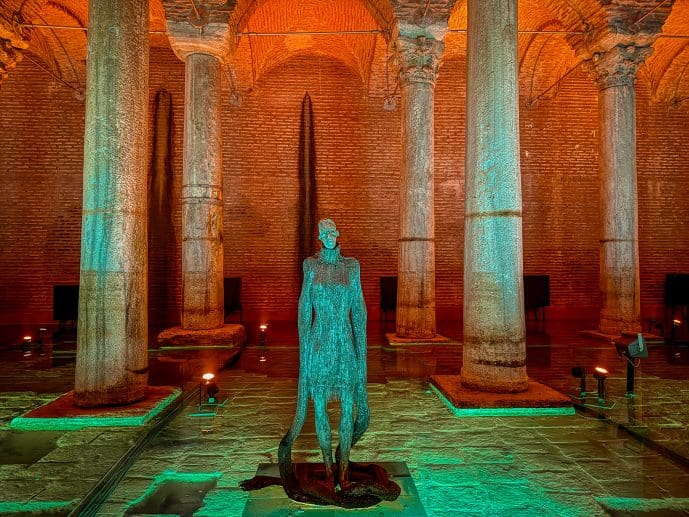
Opening times and ticket prices
Basilica Cistern is open from 9 am – 10 pm most evenings so there is lots of time to visit throughout the day.
They often close temporarily between 6.30 pm – 7.30 pm to set up the evening shows.
Ticket prices between 9 am – 6.30 pm are 600 TL per person (£15 / $18) and you can buy these online via Passo.
From 7.30 – 10 pm, the price goes up to 1000 TL (£25 / $31) for the ‘night shift’ where evening shows take place. You can only buy evening tickets at the ticket office.
I’d say the best time to go is for opening time so you can avoid queuing for too long and have a quieter experience. The evenings and weekends can be very busy.
You can get skip-the-line tickets from different companies online but these are more expensive. Always thoroughly check T&Cs to avoid wasting money.
Opening times can change regularly, check the website for the latest updates.
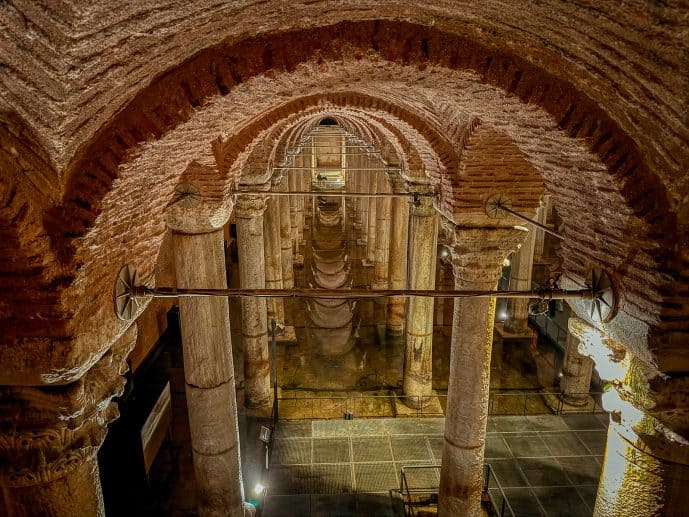
Things to do in Basilica Cistern
When you finally get inside the cistern, there is a lot to see and do. It’s a large place, so I would recommend you leave at least 1 hour to see everything.
You’ll find endless columns, exhibitions, art installations, colourful lighting and even performances in the evening.
Here are all the things to see in Basilica Cistern.
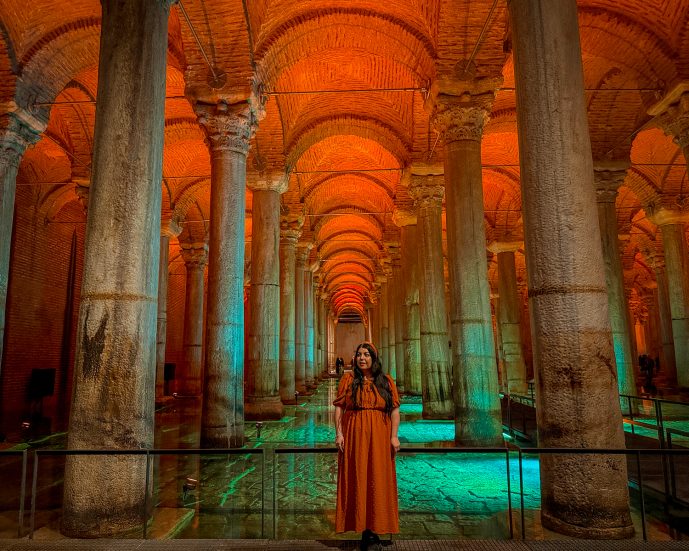
1. Explore the Subterranean Palace
As you descend the steps to the lower floor of the cistern, you will be amazed by the size of this sunken palace.
It’s 9,800 square metres and you’ll explore it with a labyrinth of walkways that allow you to take in the highlights.
With the atmospheric lighting, Corinthian columns and ancient Medusa heads, this place will feel like you’ve entered a portal to the Byzantine era.
It’s hard to believe that back in the day this room was filled almost entirely with water and locals used to come down here in boats to collect it.
Now, the water level is very low and you can see the cracked stone floor beneath when it is lit up.
You may feel drips of water that splash on you as you explore and I kept jumping when one hit me. The dripping sounds also give this place an eerie feel as the drops echo through the space.
Many people say they still see fish living here but I didn’t see any. I can’t imagine they can survive unless they have a way to swim in and out.
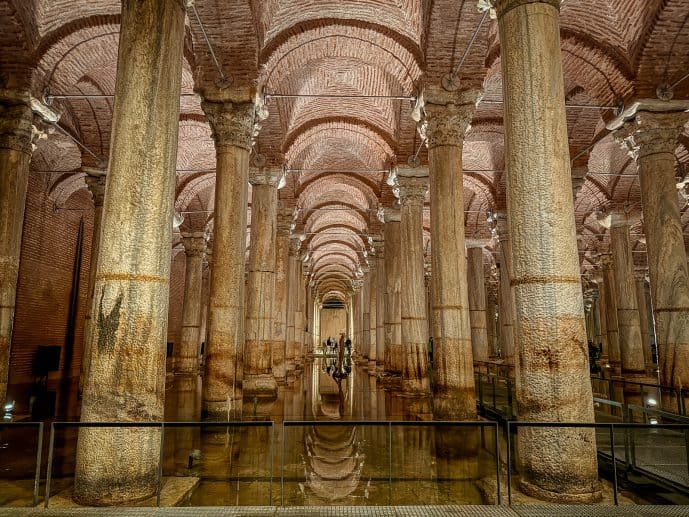
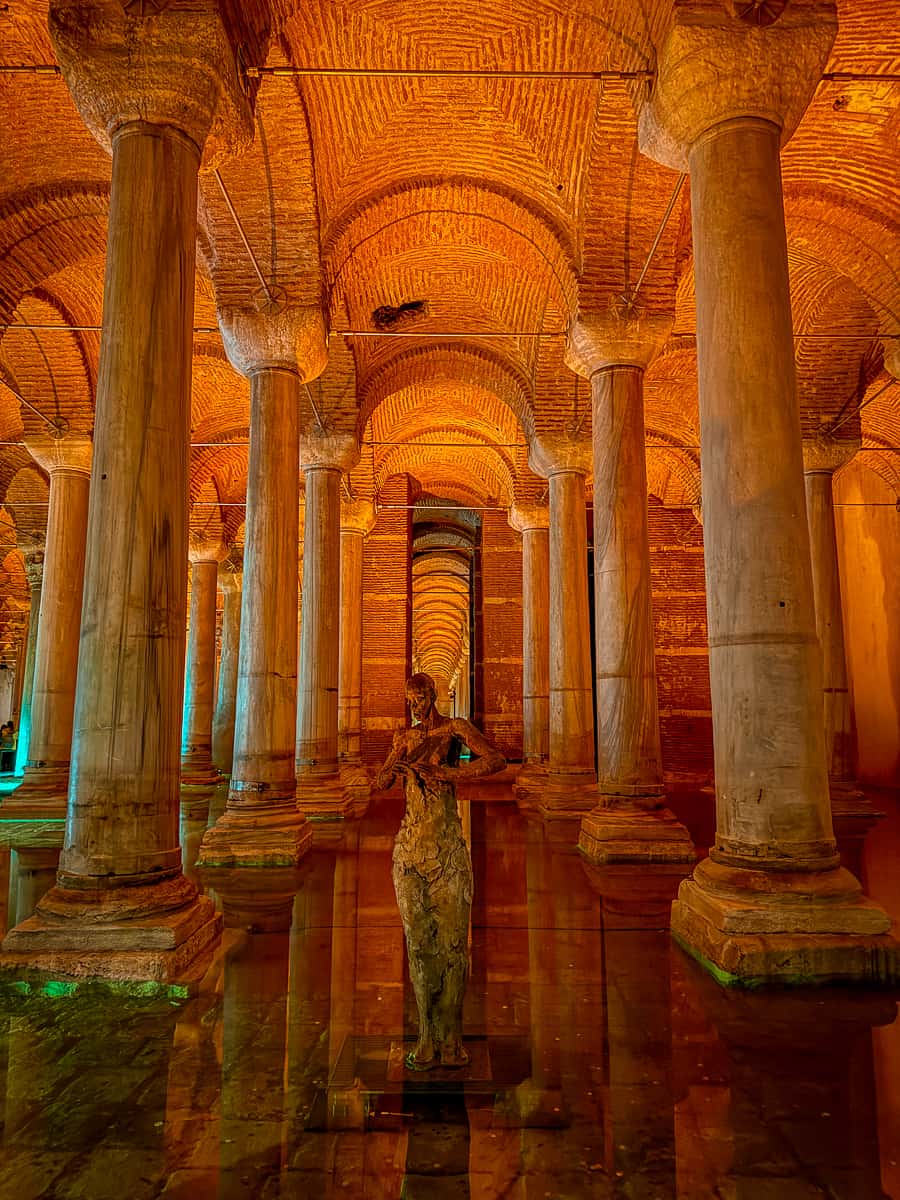
2. Does Basilica Cistern have a light show?
The cistern doesn’t have a ‘light show’ per se but does have different colour lighting that switches throughout your visit.
Before the restoration, the Basilica Cistern was always lit with a dark orange light but now they have different colours on a loop.
The standard is the white lighting which is good as you get to see the pillars and architecture easily.
However, I felt it was a little boring and did nothing to set the ambience of the place. It also didn’t tell a good story through photography, especially with the Medusa Heads.
The best lighting is the green and orange/teal and these lights come on every 10-15 minutes or so!
These colours create such a dramatic vibe and it looks so much better in photos/videos. So, you’ll see everyone scrambling to capture the place in the green and orange glow before it turns off again!
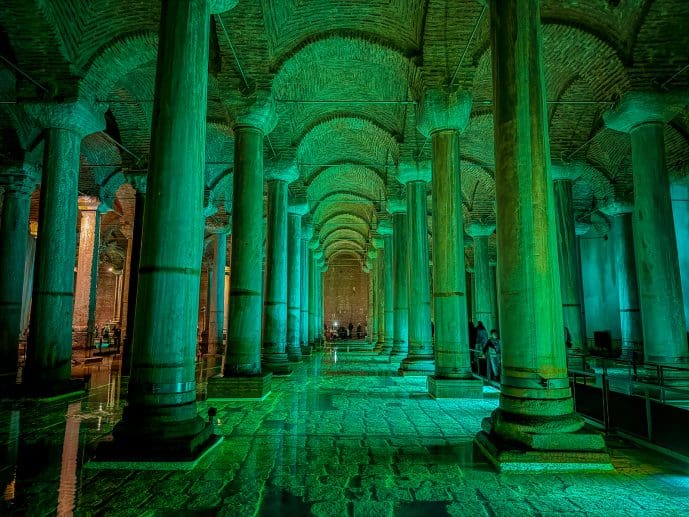
3. Admire the upside-down Medusa Heads
The Medusa Heads are the most popular things to see in the cistern as they add a touch of mystery and magic.
You’ll find two heads attached to columns, one Medusa head is on its side and half submerged in water. The other Medusa Head is completely upside down.
Many people throw coins in the water around these heads for luck or for their wishes to be granted.
I saw many people touch the Medusa heads and bless themselves with the water – this is not allowed and the security guards were getting quite angry with people because of it.
Because it was so crowded on my visit, I had to wait for ages to get a photo of these heads without many people in them.
Due to their position, it’s almost impossible. But, with a little patience, you’ll get there eventually.
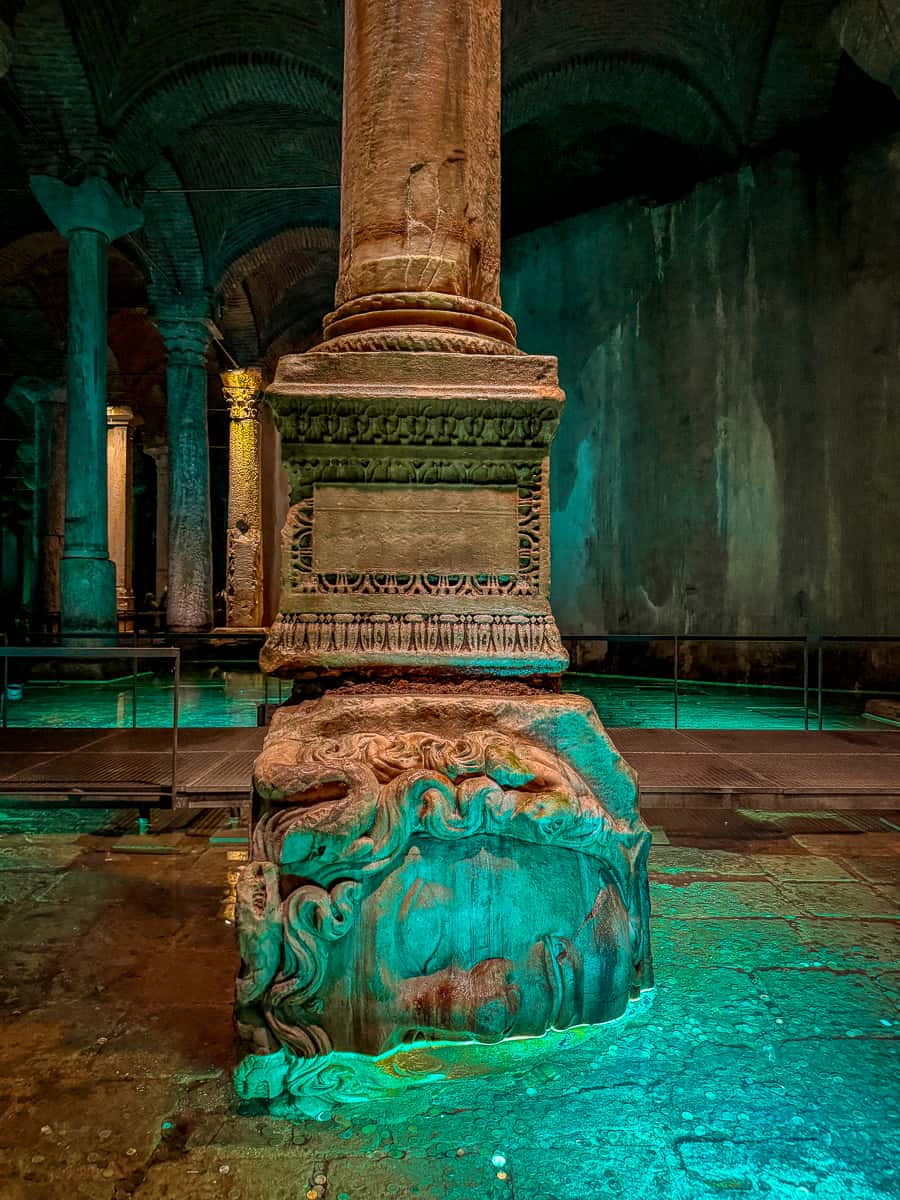
4. ‘Deeper Beneath’ art installations
A surprise for me was the modern art installations dotted around. The exhibition is called ‘Deeper Beneath’ and is a collaboration of several local artists.
These installations change often but they had such creative forged iron and steel statues. You could see glowing jellyfish, carved pillars and large hands.
My favourite was a Medusa statue by Muzaffer Tuncer called ‘Seclusion’. They played with the lighting to cast her shadow against the wall and you could see her snakes beautifully!
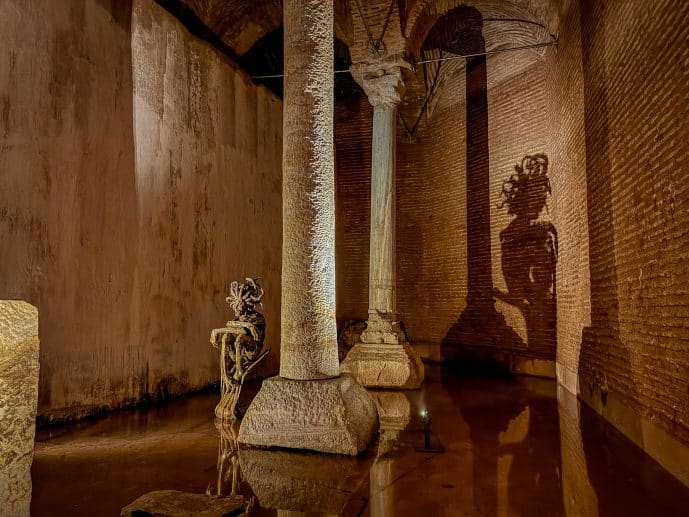
5. The Night Shift performances
If you visit Basilica Cistern in the evening, you pay more for their ‘Night Shift’ where they have performances. On my visit, I was lucky enough to watch a Whirling Dervish show!
If you’re not aware, the Whirling Dervishes or Sufis perform a ritualistic whirling dance which is a form of deep meditation.
I’ve been to a longer performance in Hodjapasha Cultural Centre before but it was nice to see it again. I highly recommend seeing a show if you have time in the city!
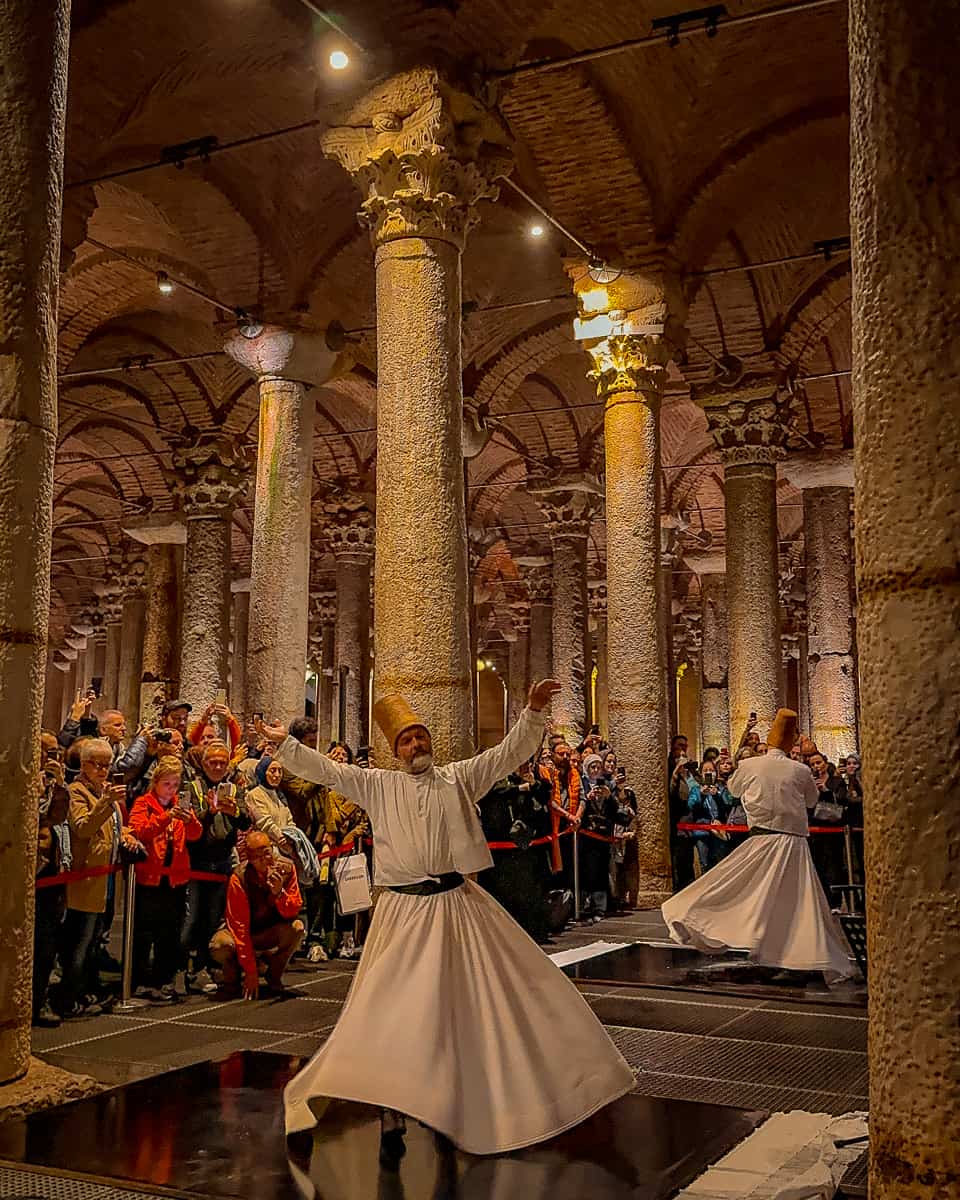
What is the best time of day to visit Basilica Cistern?
As one of the most popular attractions in Istanbul, you can expect long queues to get inside throughout the day.
I think it’s best to visit Basilica Cistern at opening time on a weekday and be one of the first visitors. The queues only get longer as the day goes on and weekends can get really busy.
Even in April, the queues were down the street and it took over an hour to get inside. I dread to think of the summer crowds.
If you’re there for opening time you will still have to wait a little while. But, it will be for much less time and you will have a far quieter experience once inside.
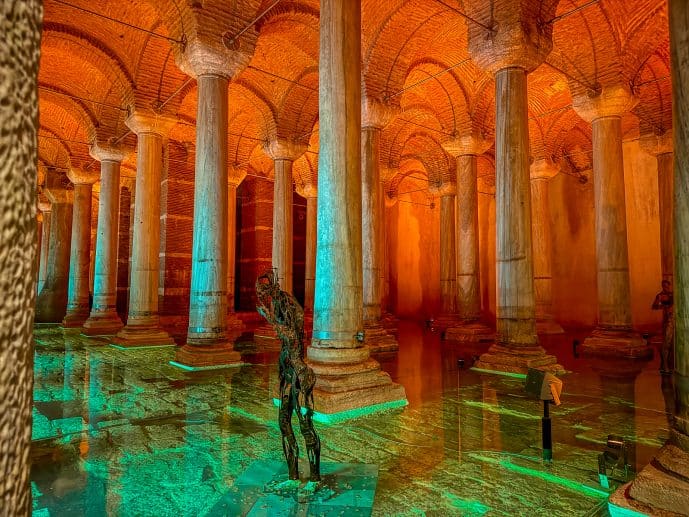
Visiting during Ramadan
During my visit, it was Ramadan and as a ‘gift’ Turkish people got free entry for the month and it was open until 5 am. There was no mention of this on the website.
This was great for locals but as the staff didn’t do any sort of timed entry or crowd control, this meant that everyone who paid for the attraction was crushed in throngs of people.
I’m claustrophobic and although the place is huge and open, the walkways are small and the crowds were horrific.
I’m not joking when I say it was hundreds of people going by a minute and I felt in a crush that I paid for the privilege of being in!
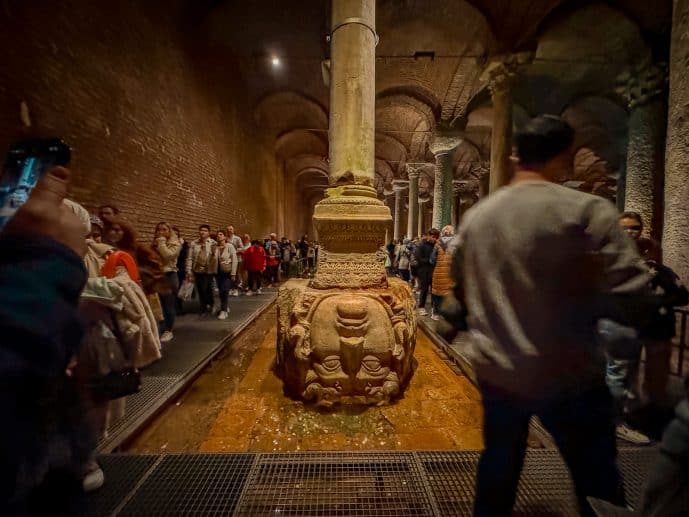
I had my hair pulled, I was pushed about, shouted at – It was just grim. I was annoyed as I’d been looking forward to visiting for years since it had been under renovation.
It really put a damper on my experience and I basically waited around for it to get quieter in the end as I wasn’t enjoying it. I got my photos at midnight / 1 am when I got in at 9 pm. Sigh.
I would have come back when it was quieter another day but I didn’t want to pay another £25 if it was going to be the same.
Even if they just had a capacity limit to the number of people inside at one time, it would have helped massively but it was relentlessly crowded and felt really unsafe.
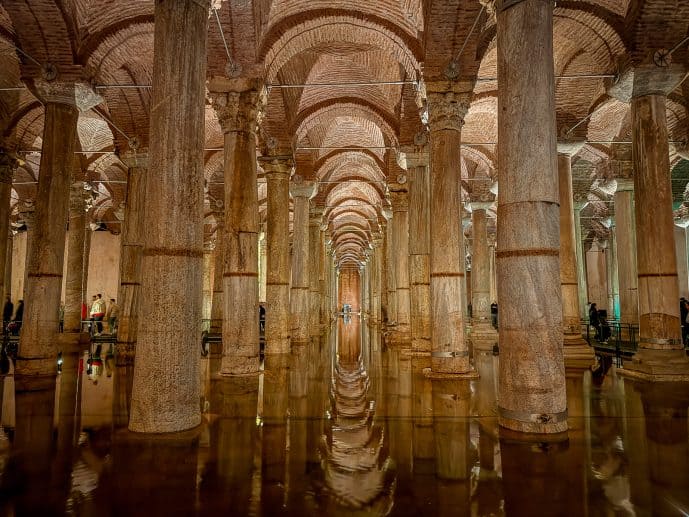
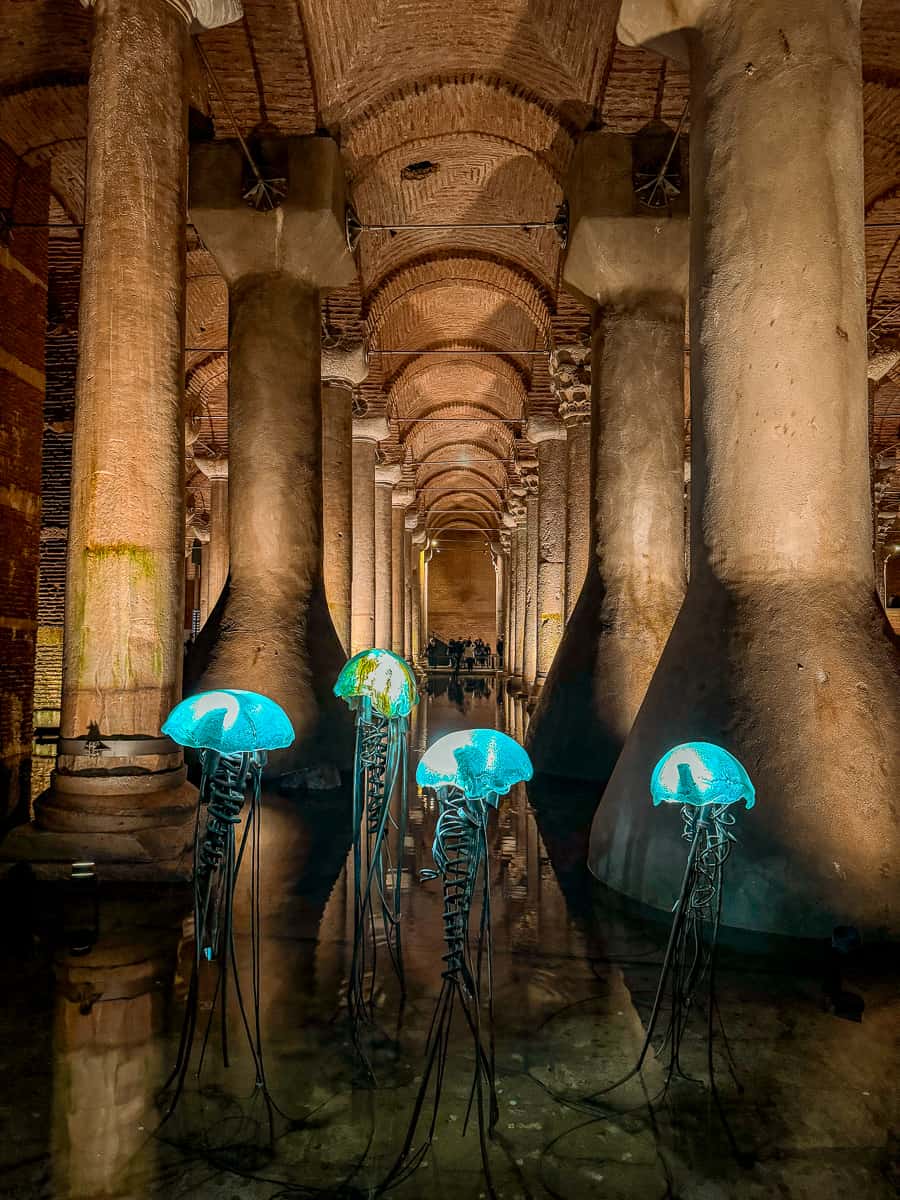
How much time do you need to visit Basilica Cistern?
I would say that you need anything from 30 minutes to an hour to visit the cistern and that doesn’t include any of the waiting time to get inside.
The cistern is huge and there’s lots to see once you’re in here. There are usually bottlenecks around the art installations and Medusa Heads so visiting at busy periods can take a while.
If you’re visiting at night time, there are often shows worth sticking around for. Plus, there are literally thousands of photo opportunities to be had.
Don’t rush your visit as this is easily one of the most fascinating attractions in Istanbul.
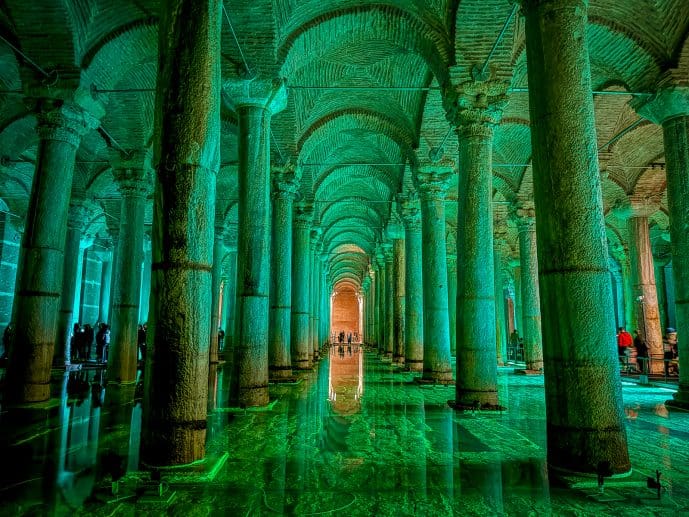
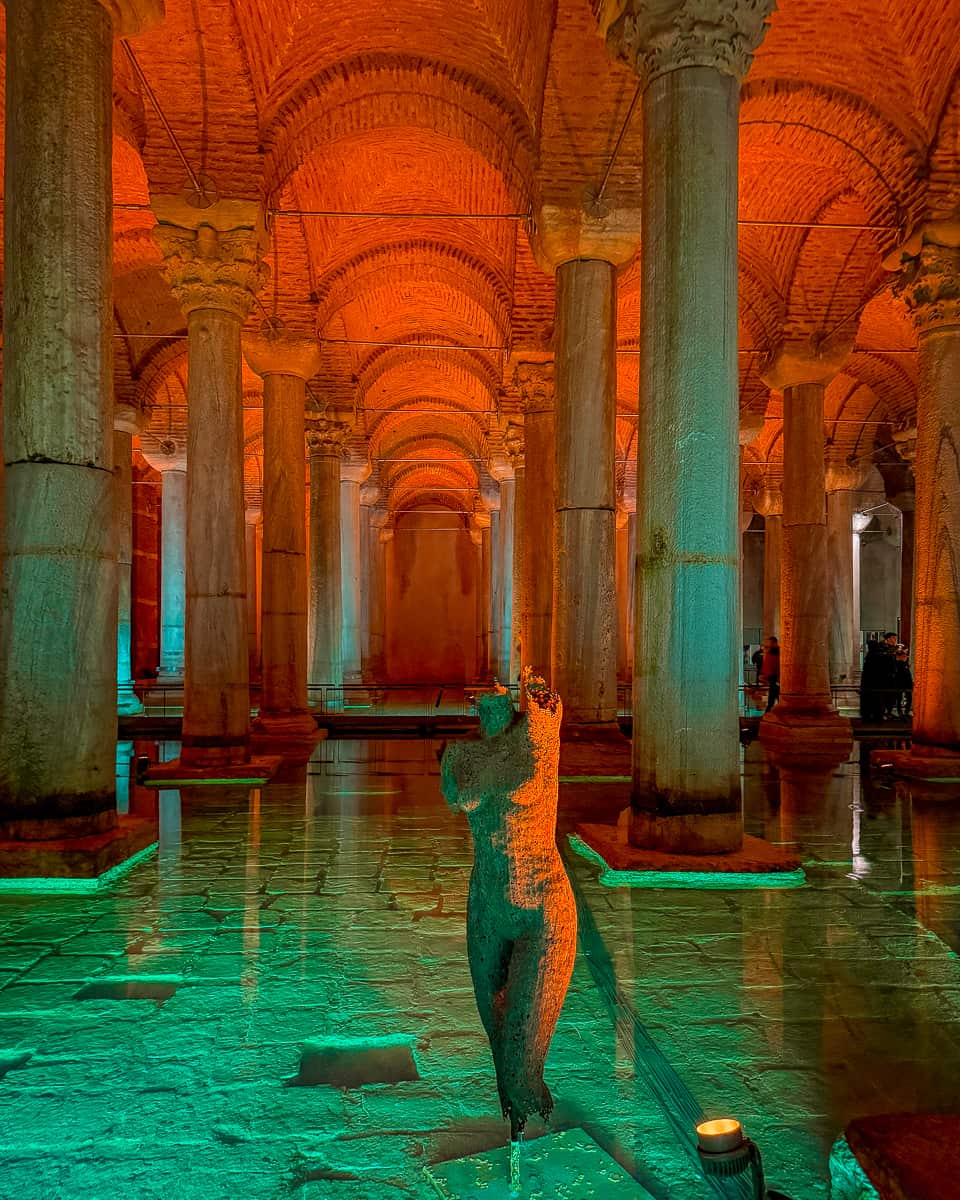
Is the Basilica Cistern worth it?
Yes, it is well worth exploring this Subterranean Palace and is a must-visit in my opinion.
Despite the issues I had during Ramadan, it’s not usually that busy and it’s normally an incredible experience.
You’ll meander through hundreds of columns that suspend a cathedral-sized water cistern underground.
The mysterious Medusa Heads and atmospheric lighting make it feel like you’ve travelled to a land of Greek mythology and the Eastern Roman Empire.
Don’t skip this incredible attraction in Istanbul, it is well worth seeing on your visit.
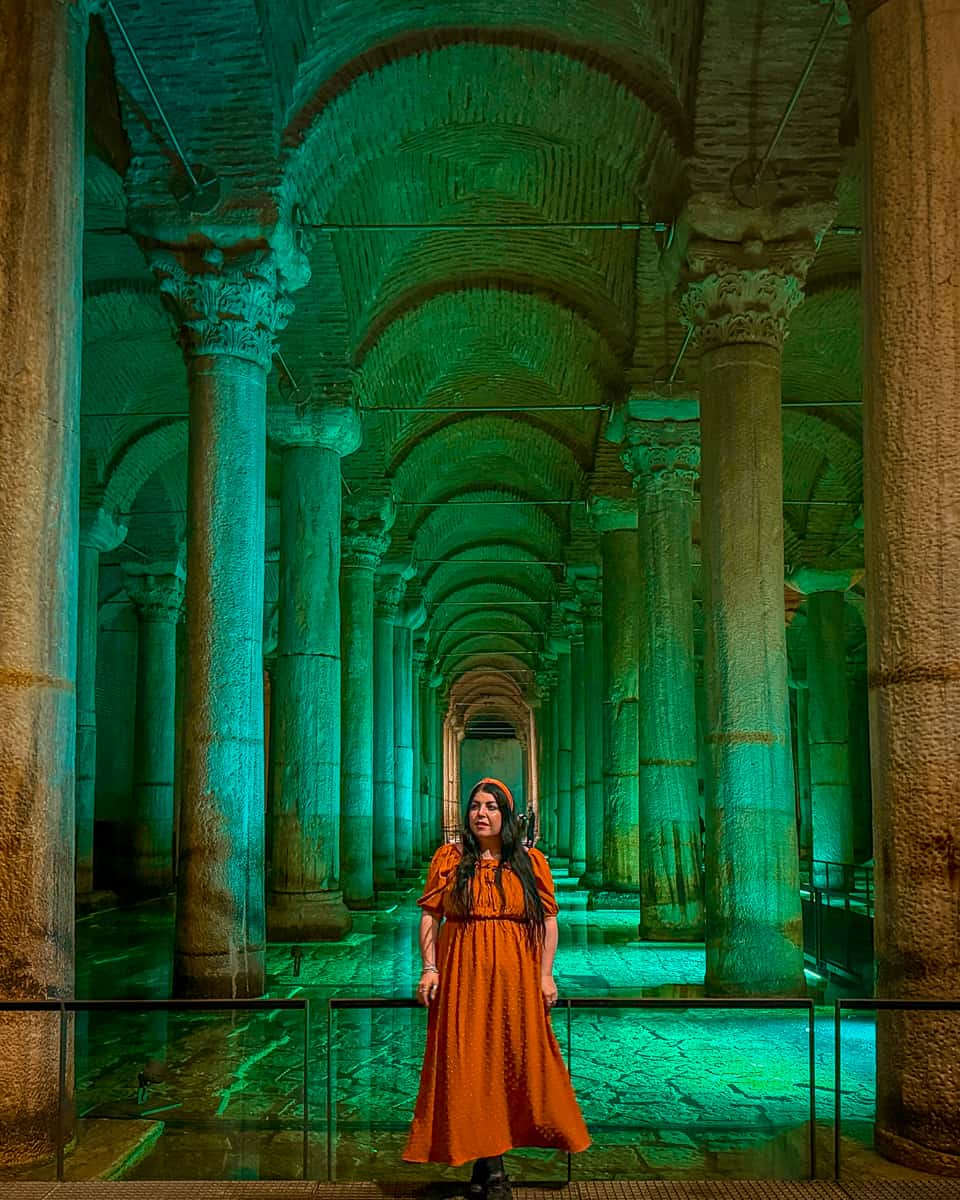
My top tips for visiting
- Go early – The queues can be quite lengthy throughout the day! I would visit when it opens for a quieter and calmer experience.
- Have patience – although massive, this place can get really busy and there are lots of bottlenecks at the main highlights. If you wanted to capture the Medusa Heads without too many people you will need patience.
- The lights switch – the best lighting is the green/orange ones but these only come on every 15 minutes or so and then only for a couple of minutes. So, when it comes on get snapping.
- It can be very dark – The attraction has very low lighting so be careful as you go and watch your step.
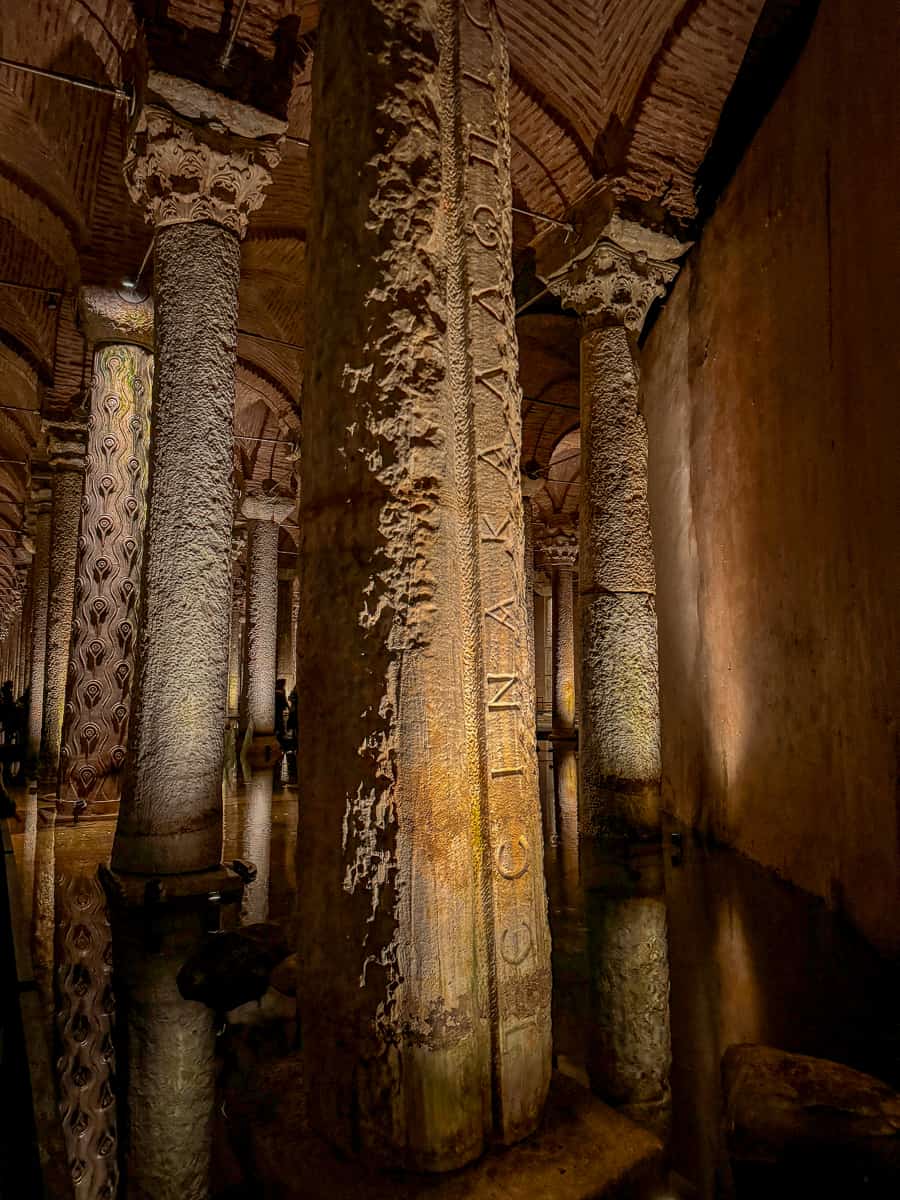
- Wear layers and sensible shoes – It felt so muggy on my visit. When I checked on the website, it says it’s 96% humidity inside! So, I’d wear layers in case you get too hot. There will be drops of water from the humidity and pathways can be slippery. So, sensible shoes are recommended.
- Steps – there are quite a few steep steps to get down to the lower floor. There is an accessible elevator for you to use. Once you reach the bottom, the attraction is entirely flat.
- Wheelchair / Pushchairs – both wheelchairs and pushchairs can go inside. There are no steps once you’ve taken the elevator to the lower floor.
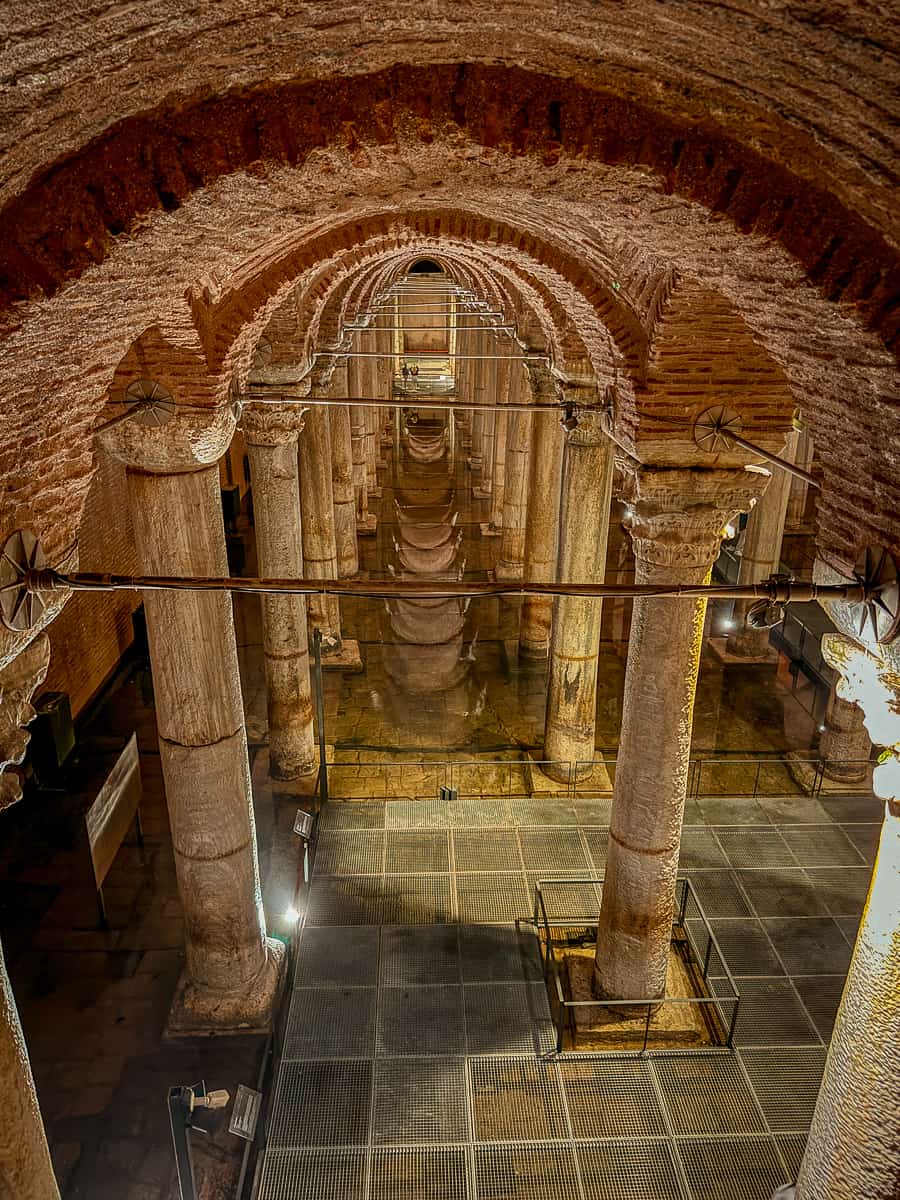
Why not visit the Cistern of Theodosius nearby?
Although the Basilica Cistern is the largest cistern in Istanbul (that we know of), it’s not the only one you can visit. There are hundreds of cisterns underneath the city streets.
The Cistern of Theodosius (Şerefiye Cistern) is another subterranean cistern in Sultanahmet that is held up by 32 columns and has a fun audio-visual projection show you can watch as you explore.
It was built by Roman Emperor Theodosius II between 428 and 443 and was again built to store water provided by the Valens Aqueduct.
This viaduct is nowhere near as busy as Yerebatan Cistern and has hardly any queues throughout the day. You can also buy tickets online.
The show repeats every 15 minutes or so and covers the long history of Istanbul from the Byzantine era up until the Turkish Republic.
There’s no speaking, it’s just pictures and music. So, it’s easy to understand wherever you’re from.
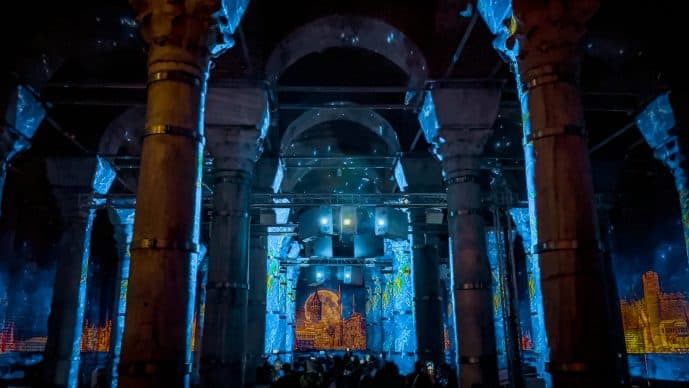
Things to do in Sultanahmet
Basilica Cistern is ideally located in Sultanahmet which is the historic and tourist hub of Istanbul.
Here, you can visit palaces and monuments from the Roman and Ottoman Empires as well as underground cisterns and historic bazaars.
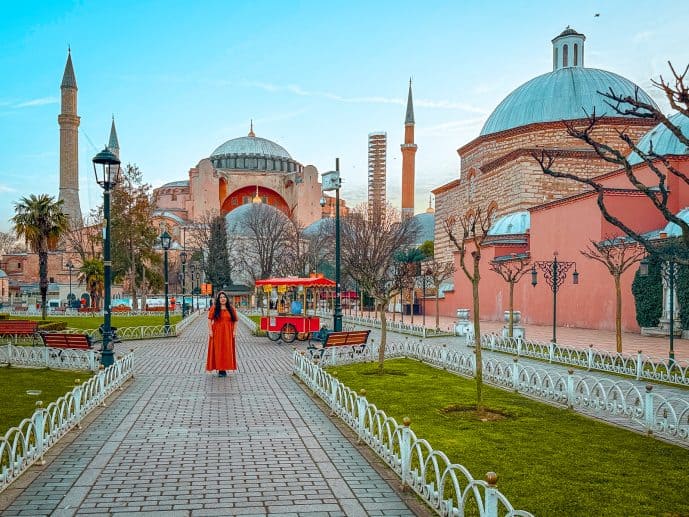
Topkapi Palace
Ah, the magical Topkapi Palace! This is one of my favourite attractions in all of Istanbul.
This residence was the official seat of the Ottoman Empire from the 1460s until the Dolmabahce Palace was built in 1856.
It was originally founded by Sultan Mehmed II (The Conqueror) and was expanded by his successors over time.
It has four courtyards, two welcome gates and over 400 rooms including an extensive harem, presentation hall, library, kitchens and mosque containing holy relics!
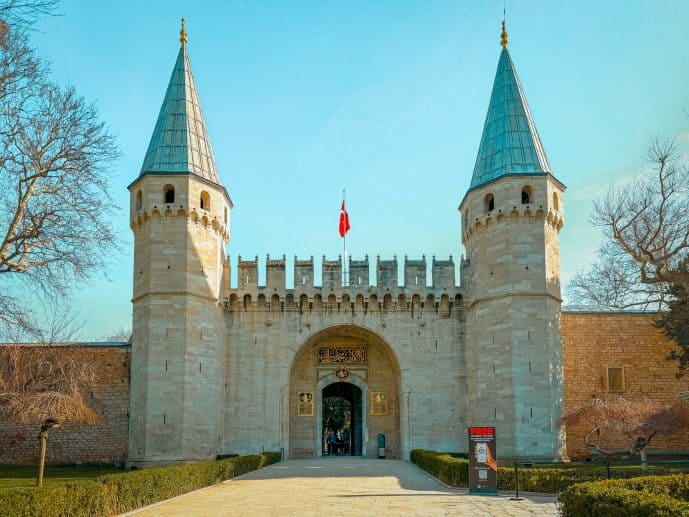
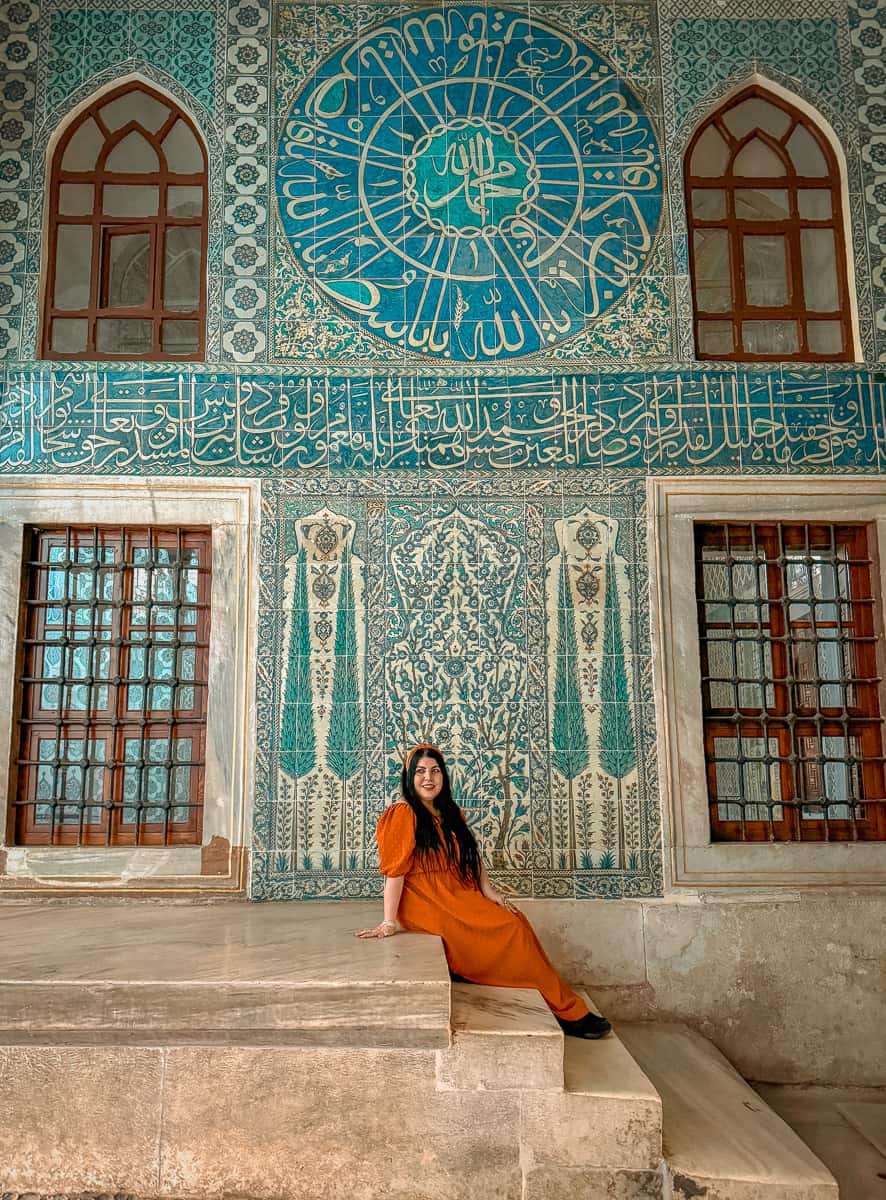
Today, many of these rooms are open as exhibits to explore and you could honestly spend a whole day here at the palace if you have the time.
There are several ticket options but I wouldn’t skip the Harem which requires a separate cost as this is the most beautiful part of the palace.
I’ve been here three times and I swear I still haven’t seen everything as it’s a labyrinth.
After your visit, be sure to stop by the Hagia Irene, a historic Eastern Orthodox church on the grounds.
You can visit the outer gardens around the palace for free and these take you for a stroll near the Bosphorus which is lovely. You do have to go through security though.
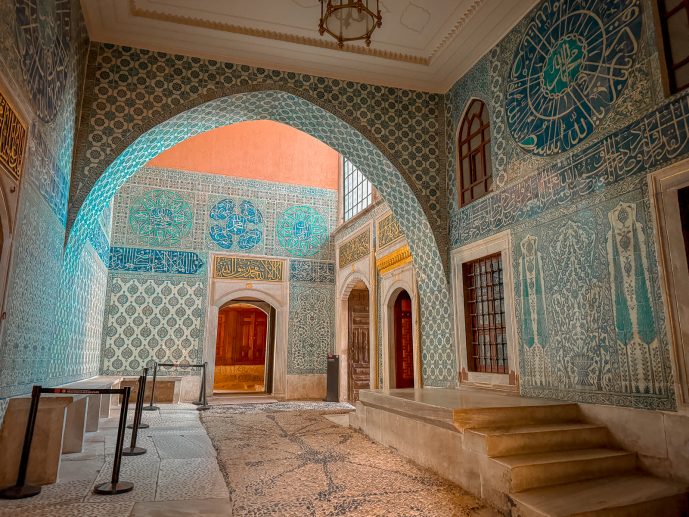
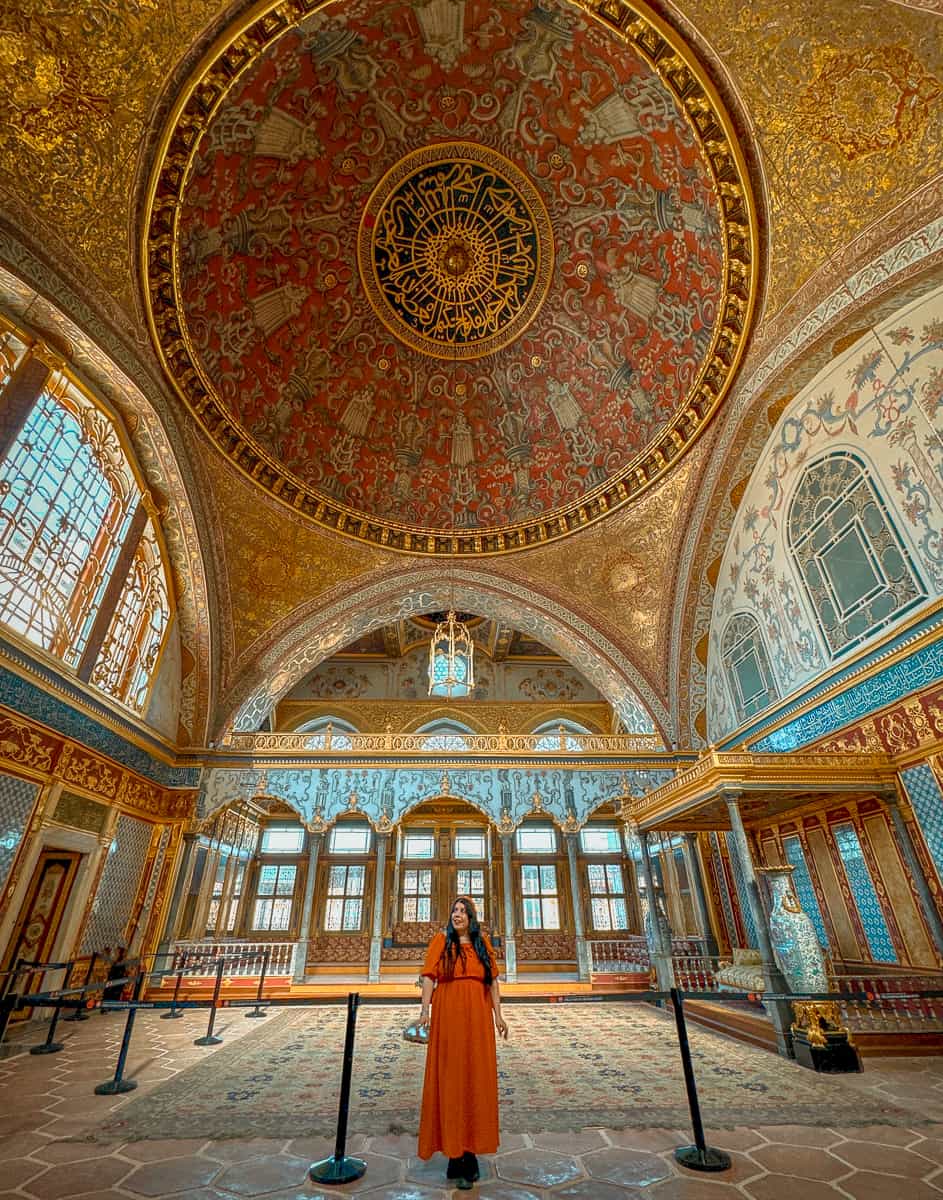
Hagia Sophia & History Museum
You really cannot leave Istanbul without stepping inside the Hagia Sophia, a religious building with a tumultuous history since the Eastern Roman Empire.
It’s been several churches, a mosque, a church-museum and now is officially the Grand Mosque. So, you’ll find lots of influences from Christianity and Islam inside.
Very recently, they have started charging tourists to visit and there are usually huge queues at the entrance. One is for tickets, the other for security.
I have been to Hagia Sophia many times and I have never seen queues so long. It felt very unorganised and the queues went all the way back at least 1km to the Blue Mosque!
Even if you buy skip-the-line tickets online you can’t avoid the security queue and this is usually around an hour or longer.
Try to avoid Fridays as they close for prayers and queues are always a lot bigger.
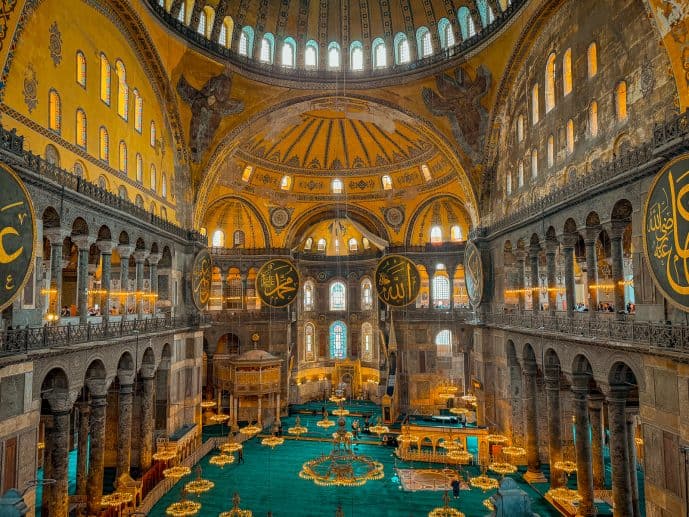
My advice is to be there for opening time and, if you can, split up your party to stand in both queues to save time. So, one waits for tickets and the other in the security line.
You can only enter the upper gallery of the mosque and this has a view of the temple below. But, you get to see the beautiful mosaics and domed roof from up there.
Shoes can be kept on for your visit but as an active place of worship, women will need to cover their heads.
When you purchase your tickets its worth adding on the Hagia Sophia History Museum, a relatively new audio-visual experience that tells the amazing story of this monumental attraction.
Note: If you identify as Muslim, from any country, you can enter Hagia Sophia through the main entrance on the ground floor for namaz (prayers) and you will not be charged.
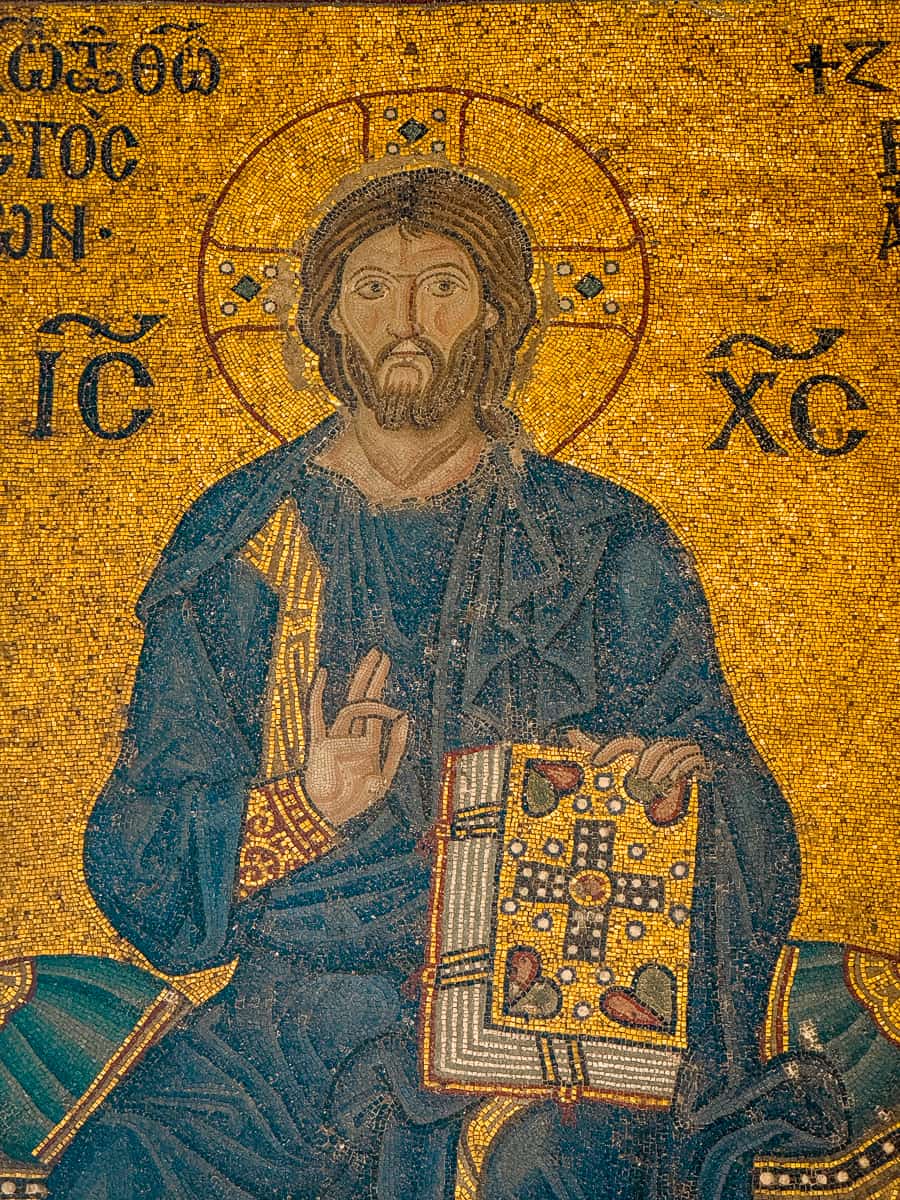
Blue Mosque
The Sultan Ahmed Mosque, known as the Blue Mosque, is one of the prettiest mosques in the city.
It was constructed in the 16th century during the Ottoman Empire and is still a working mosque to this day.
If you thought the outside was stunning, just wait until you get inside! The details and patterns on the domed ceilings are outstanding.
The Blue Mosque is free to visit and is open to visitors throughout the day outside of praying hours.
Your shoes must be taken off and women must cover their heads with a scarf also mini skirts or shorts can’t be worn.
If you aren’t dressed appropriately, you can borrow a covering and scarf at the entrance of the mosque.
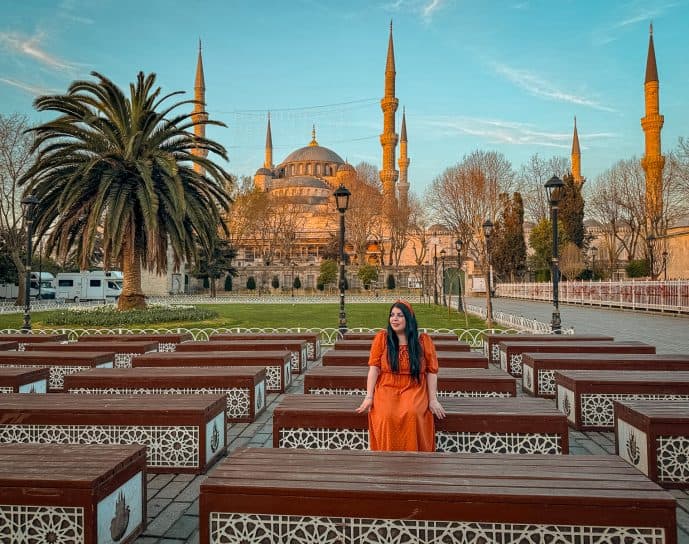
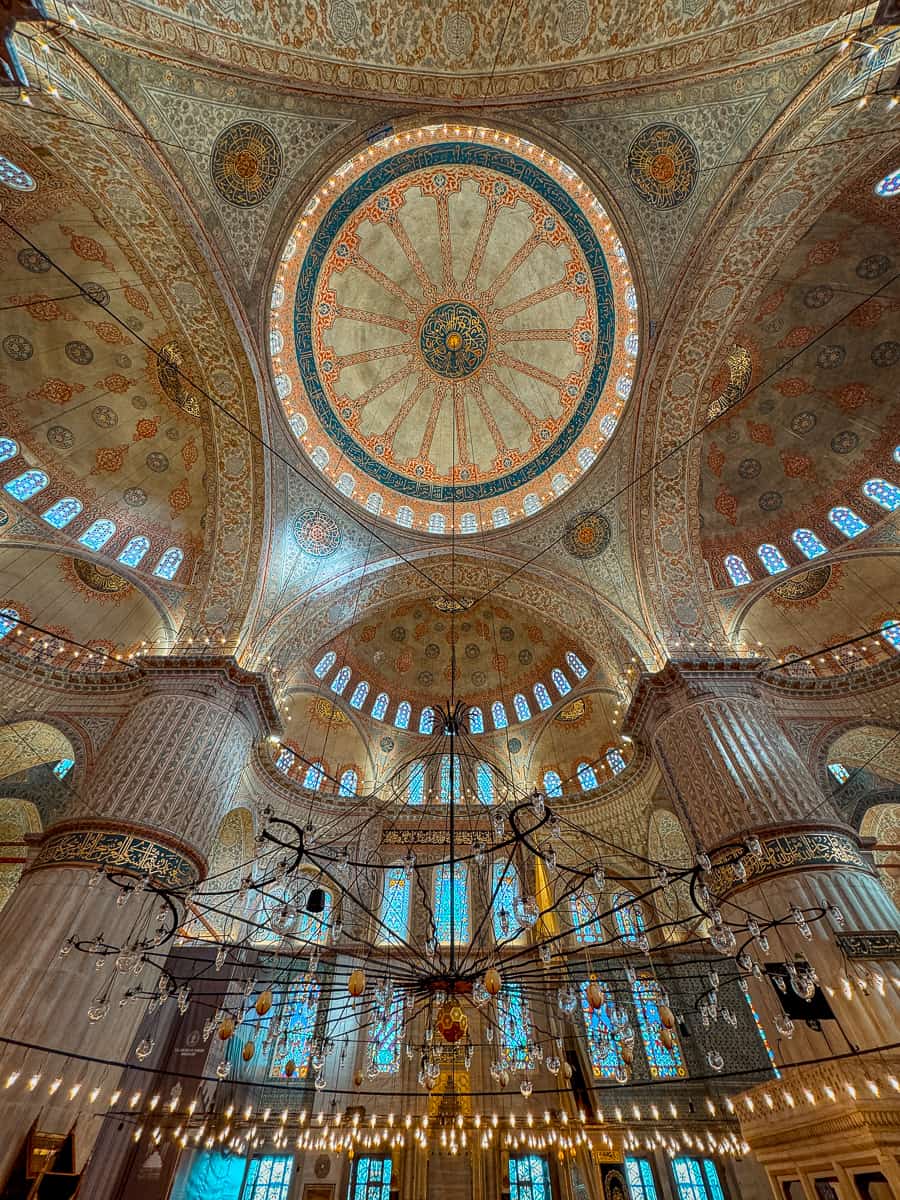
Seven Hills Restaurant
If you’re looking for a restaurant with magical views in Sultanahmet then look no further than Seven Hills Restaurant.
They have a panoramic terrace that overlooks Sultanahmet Square with unrestricted views over the Hagia Sophia and Blue Mosque.
It’s the perfect place for photos and they even have a dedicated area where you can capture your visit.
You can dine on delicious freshly caught seafood from the Marmara Sea or a traditional Turkish breakfast whilst overlooking historic monuments like the Topkapi Palace.
Also, you can see boats sailing down the mighty Bosphorus Strait with views over towards the Galata Tower.
It’s great to fill up on breakfast for a day of sightseeing in Sultanahmet.
Click here to read more on the Seven Hills Restaurant Rooftop
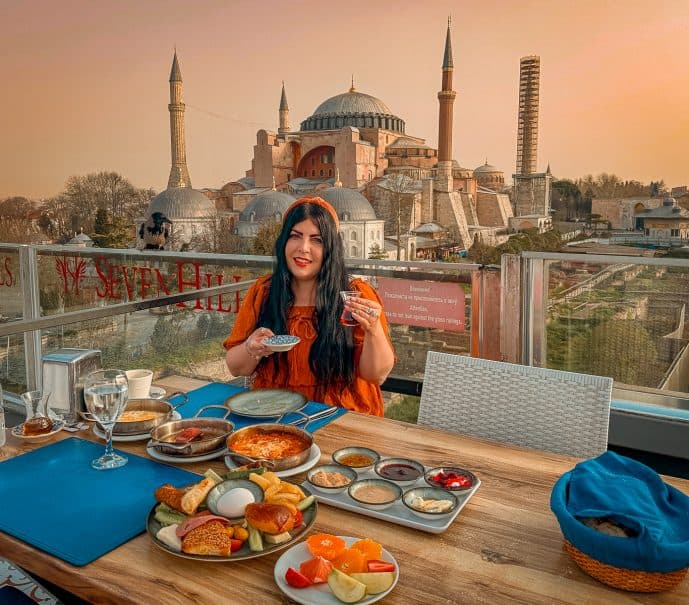
Grand Bazaar / Egyptian Bazaar
If you’re looking for souvenirs or to do some shopping, you must visit the Grand Bazaar!
It’s one of the largest and oldest covered markets in the entire world that was established in the 15th century.
It has 61 streets and over 4,000 shops inside as well as a book bazaar and antiques section.
It is quite touristy so expect tourist prices but don’t be afraid to barter as they will mark it up a lot!
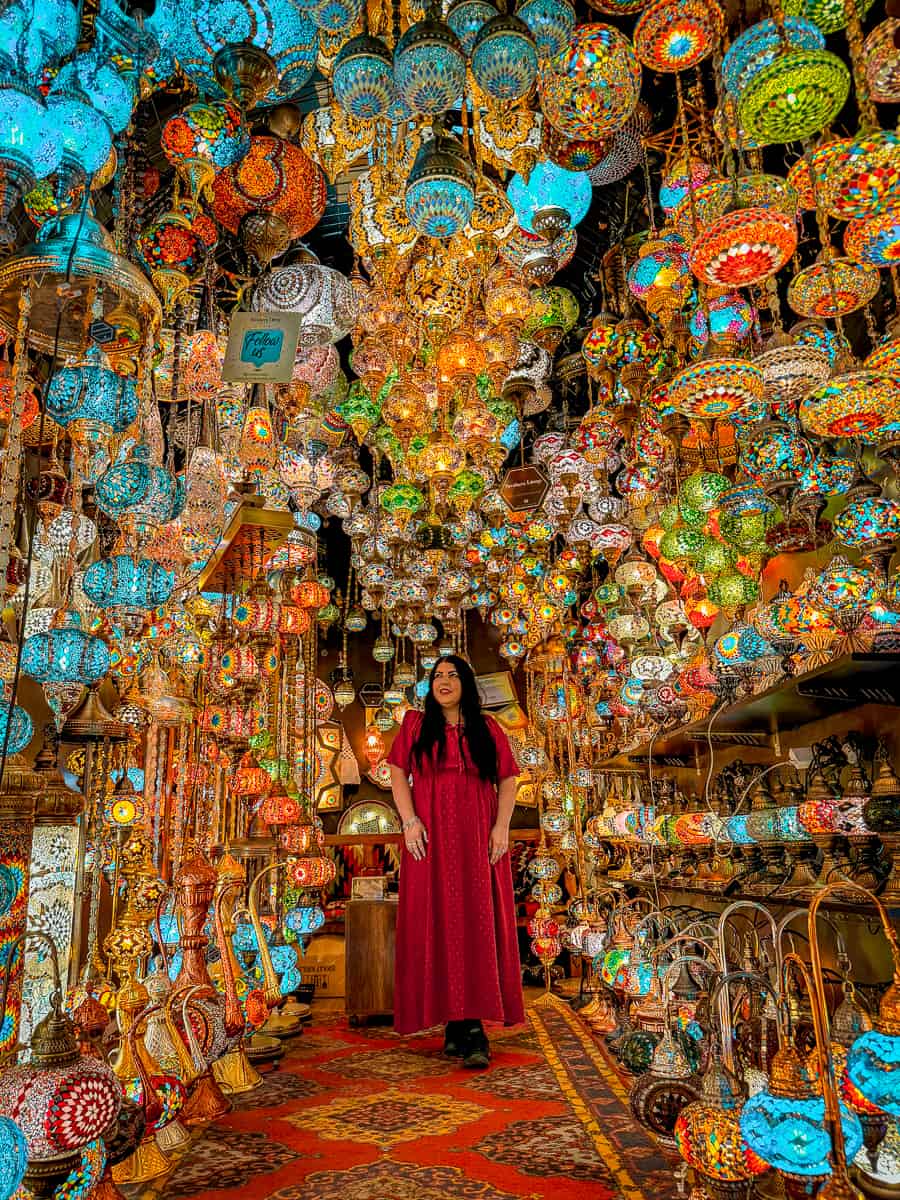
Also, try not to engage with any stalls you’re not interested in purchasing items from or you could be there all day. The sellers here are relentless!
For a more local experience, I would actually opt for the Egyptian Bazaar or Spice Bazaar which is near Eminou.
This area is also lively but they have more authentic Turkish souvenirs and food gifts like baklava, sweets, tea, coffee etc.
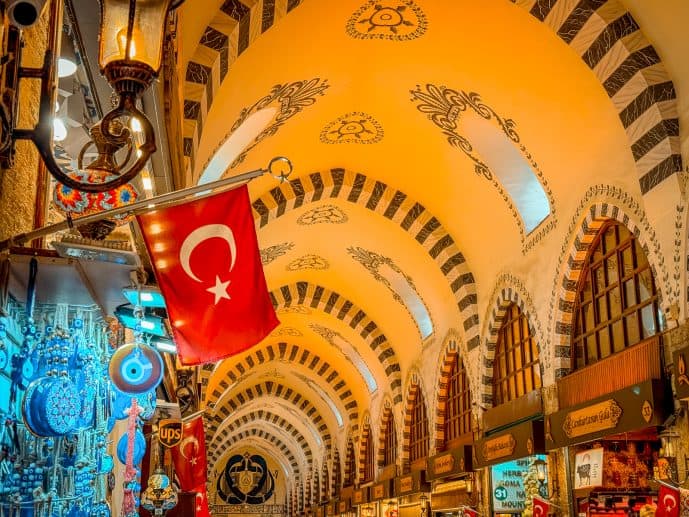
Basilica Cistern FAQs
- Why is it called Basilica Cistern? Because it used to lay underneath Stoa Basilica on the First Hill of Constantinople.
- Is there a dress code for the Basilica Cistern? No, there’s no dress code. You can wear what you like. But, layers are good due to the humidity and sensible shoes are recommended as the walkways can be slippery.
- Is Basilica Cistern free? No, you have to pay and tickets are 600 TL before 6.30 pm and 1000 TL for the night shift.
- What is Basilica Cistern famous for? The upside-down Medusa Heads inside that date back to the Roman Empire!
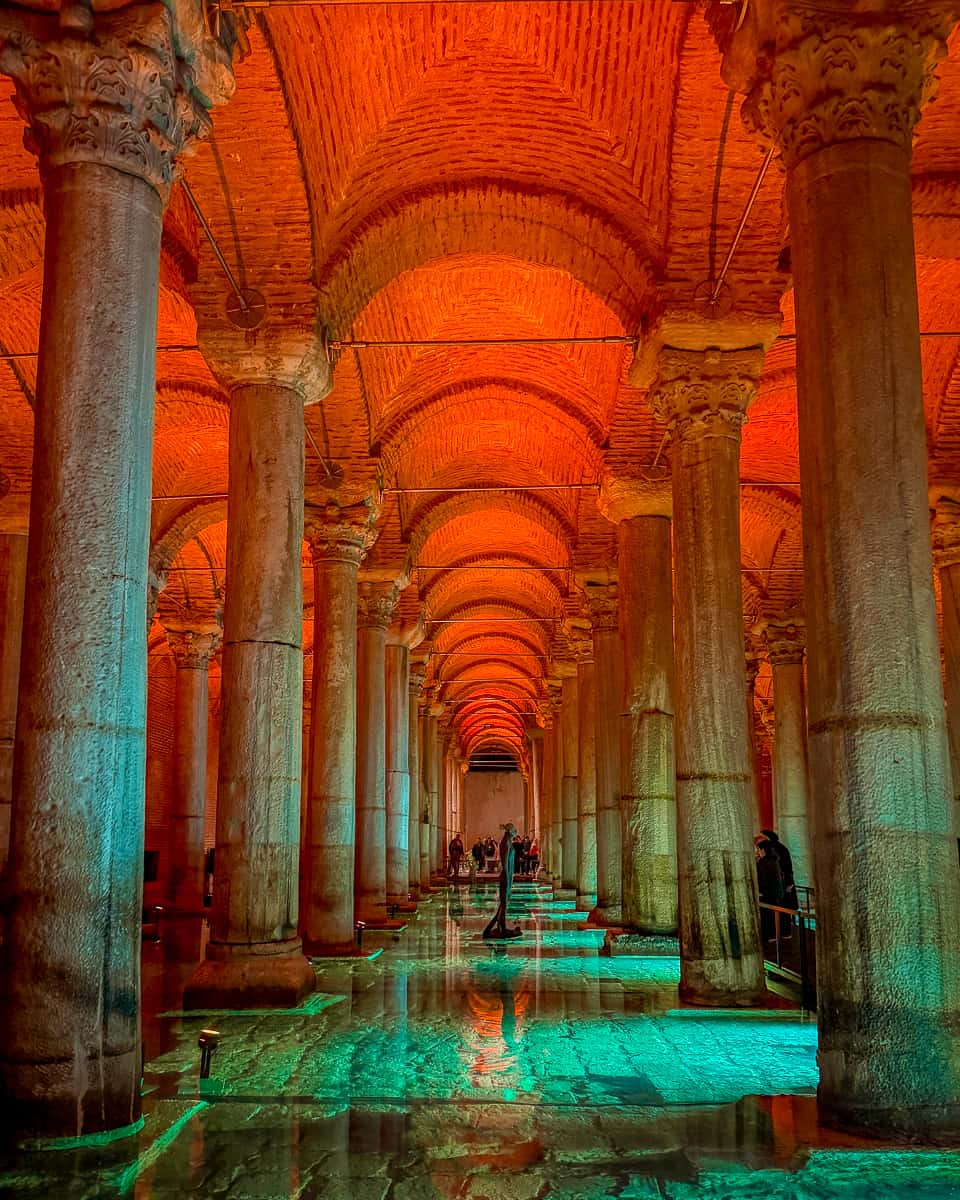
- How long is the queue for Basilica Cistern? This depends on the time of day you go and the season. In the morning it has a much shorter queue so this is when I recommend you go. It can take up to two hours in summer. You can get skip-the-line tickets but these are more expensive and often require you to be part of a tour group.
- How big is the basilica cistern? It’s cathedral size at 98,000 square metres and could hold 66 million litres or 17.5 gallons of water.
- Can you use the Istanbul Museum Pass in Basilica Cistern? No, everyone must pay for tickets here.
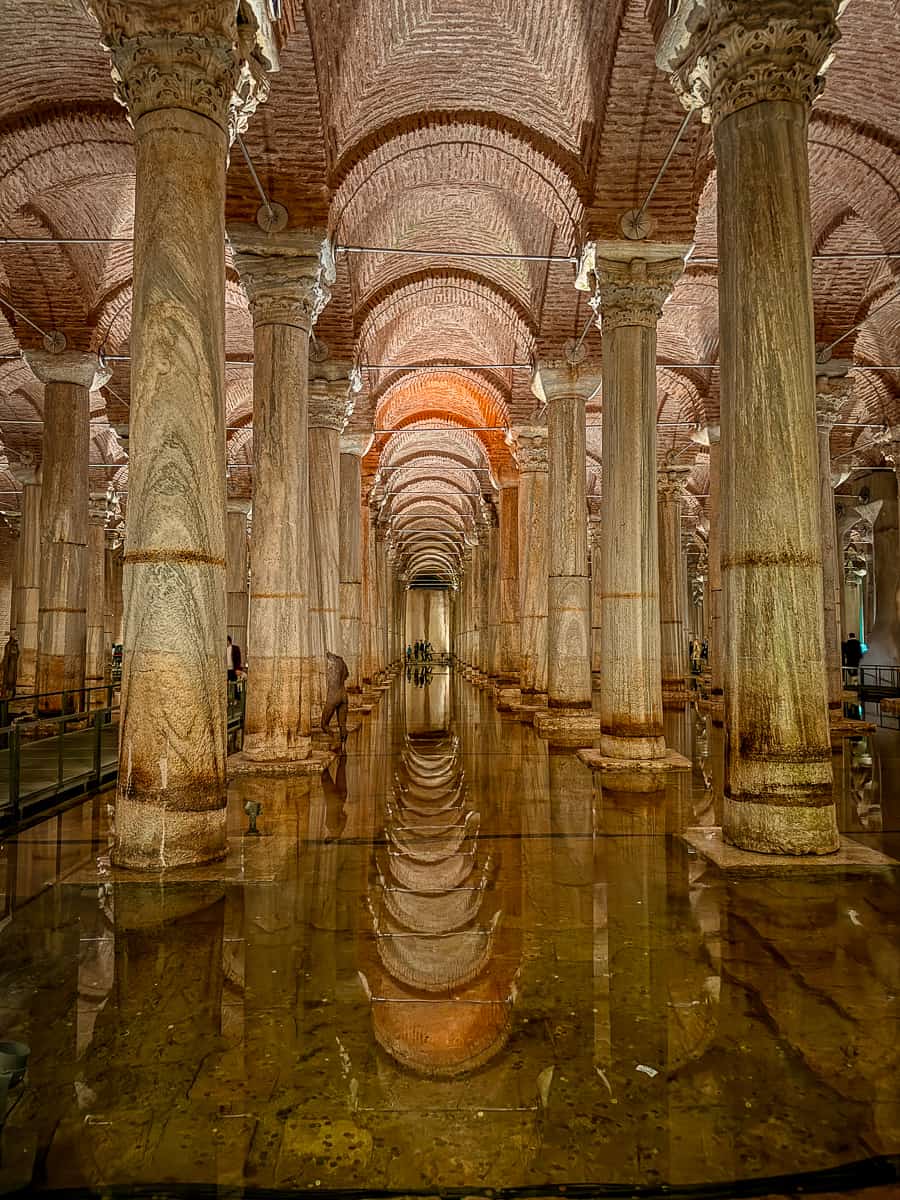
Read more of my Istanbul guides
How to visit Beyazıt State Library in Istanbul
Things to do in Balat – Istanbul’s most colourful area
The most Instagrammable places in Istanbul
The sad story of the Rainbow Steps of Istanbul
Hafiz Mustafa 1864 – best Baklava in Istanbul
How to spend a weekend in Istanbul
Save How to Visit Basilica Cistern in Istanbul for later!
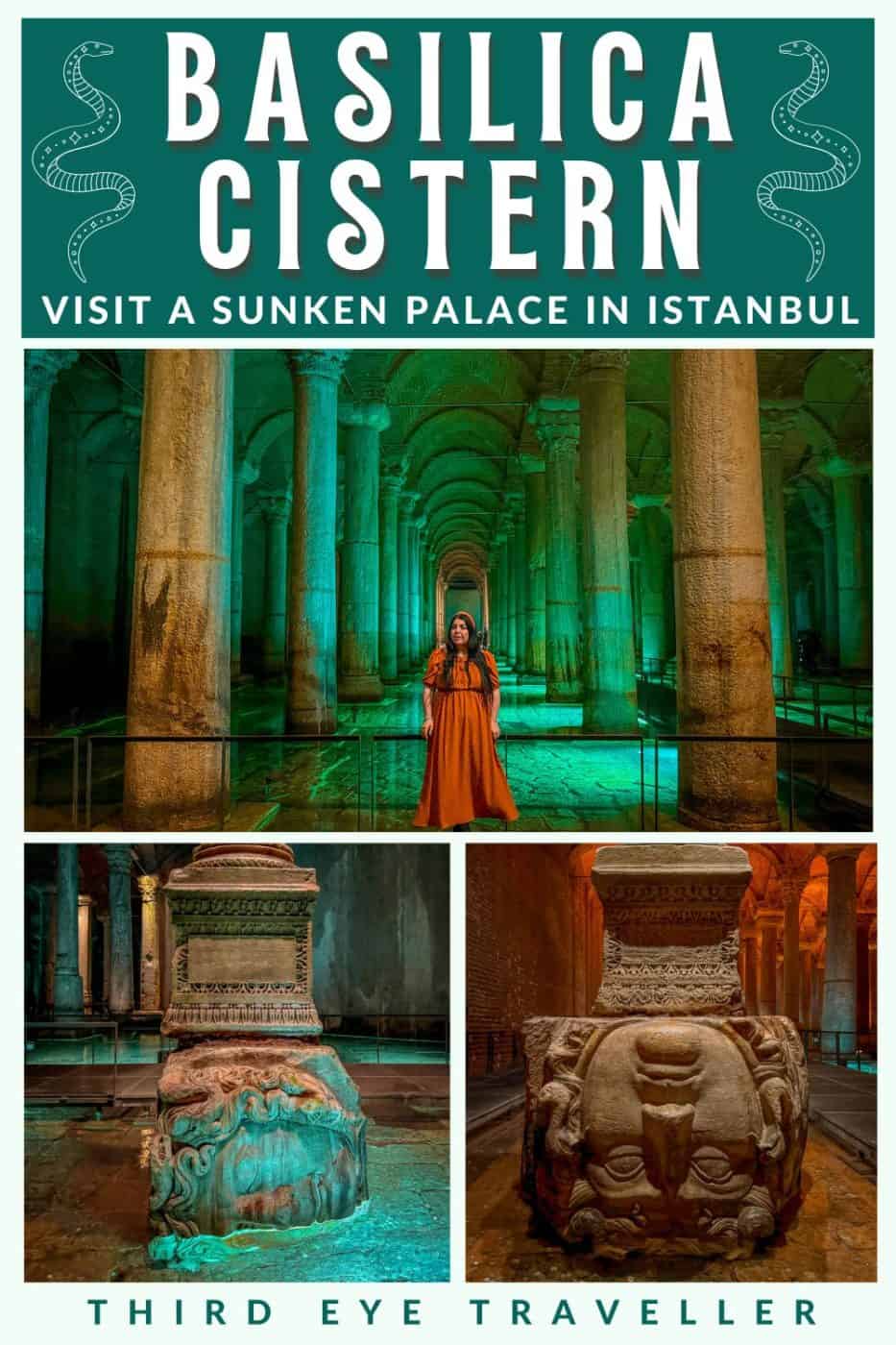

Alison
Friday 5th of April 2024
Looks beautiful! Great photos makes me want to visit
Sophie Pearce
Friday 5th of April 2024
Thanks so much Alison, hope you get to go one day! x